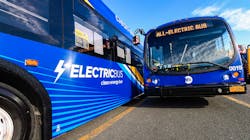Why Zero-Emissions Fleet Transformation Starts at the Top
Decarbonizing our transportation system is one of the top challenges of our time and comes with several considerations, including social equity, resiliency and safety. To this end, an increasing number of government agencies and fleet operators across the country are transitioning their fleets to zero-emission vehicles (ZEVs) to minimize their carbon footprint. California took the lead, with New York and other states quickly following suit. The federal government has provided financial incentives to governments and public agencies who successfully convert 100 percent of their light-duty non-emergency vehicle fleets to ZEVs by 2035 and 100 percent of their medium- and heavy-duty vehicle fleet to ZEVs by 2040.
Why zero-emission technology had a slow start
Despite these ambitious plans, to date, the incorporation of zero-emission technology, most notably, of battery electric and hydrogen fuel cells, has been slow, primarily due to the complexity and expense of installing the needed charging/fueling infrastructure, as well as power requirements and the anxiety of fleet operators around these developing technologies. These problems were further exacerbated by the COVID-19 pandemic, which disrupted supply chains and slowed production.
New York City: A case study
With 2035 and 2040 looming, fleet operators know the time is now to overcome these challenges to ensure a successful transition to zero-emission technology. New York City Transit (NYC Transit) learned from its pilot program getting the friction points out of implementation was critical, and that began by solidifying its organizational structure to be set up for success.
NYC Transit’s journey to a zero-emission bus fleet began in 2018 with a pilot of 10 electric buses. This small pilot, which involved two facilities and a limited number of routes, provided insight on how this technology would integrate into its operations and what would have to change to achieve this. Initially, the pilot was managed by the organization’s chief maintenance officer, who had fleet and procurement expertise.
Within a short time, a few clear challenges emerged:
- Each bus manufacturer had its own proprietary charging protocols.
- Limited battery range could not support approximately one third of its existing schedules. That meant it was necessary to explore other options or wait for the technology to improve to maintain service reliability.
- The pilot yielded important data on the impact of temperature on battery usage and range and brought into focus the complexity and know-how needed to build both in-depot and on-street charging infrastructure, as well as the amount of power needed to draw from the utility company.
- To maintain reliable service, the team needed to build redundancy and resiliency into its charging strategy.
As NYC Transit contemplated next steps and the long-term vision and strategy to transition to 100 percent ZEVs, it recognized a limited pilot project was vastly different from a full fleet transformation. Without organizational buy-in and an organizational framework, NYC Transit was simply not positioned for success. There was also a pressing need to engage its workforce and other stakeholders from the outset, and in a coordinated manner, to enable them to fully participate and contribute to a successful transformation.
To successfully transition the entire fleet, NYC Transit needed to implement a change management process at the top that prioritized driving change at an organizational and employee level.
To begin addressing these issues, the program moved from underneath the chief maintenance officer to a newly created Zero Emission Program Management Office, reporting directly to the office of the president. This organizational change demonstrated leadership commitment at the highest level while creating an autonomous, focused and empowered project management team. The new program management officer was charged with program planning, program leadership and coordination of existing work streams managed by multiple areas of the organization, but all accountable to the program manager. New project workstream owners were selected and given the resources to empower them to deliver across the various disciplines of power, infrastructure, fleet, procurement, funding, operations planning, workforce development, community relations, policy, information technology and operations.
Another key decision was to maintain accountability within the business/fleet operator (i.e., the Bus Department) because success would ultimately be measured by the “business owner’s” adoption of the electric fleet.
Significantly, the new Program Management Office also formalized lines of communication, engagement and training at all levels of the workforce and with key external stakeholders. Ultimately, all these entities can make or break the success of the program, so it’s critical to schedule periodic meetings with the project leaders and the governance committee, labor unions and external stakeholders such as local fire departments and government partners.
Why engagement matters
While the initial focus of the transition may be the implementation of new technology, workforce participation and evolution are critical to the ultimate success of the program. The transition from diesel mechanics to electrical maintainers, from facility electricians to electrical and power engineers, and from fleet command centers to fleet and power control centers are integral parts of this journey. Some essential areas of engagement include:
- Workforce training starting before or concurrently with the delivery of the first all-electric bus.
- Emergency training and coordination in the case of incendiary battery damage and thermal events to include local fire departments, road and tow truck crews and bus operators.
- High-voltage training for diesel mechanics and facility maintainers.
- Operational training for operators to convey that electric vehicle have steeper acceleration and braking profiles than diesel buses.
- Additional education, so depot staff can learn both the importance and nuances of battery charging.
This does not happen overnight or even within one year, but establishing a top-down organizational structure and strategic change management plan is a critical first step to successfully transitioning to an equity-focused, resilient and sustainable zero-emissions fleet.
--------------------
Craig Cipriano is the senior vice president, national director of Zero Emissions Mobility at STV and has more than 33 years of experience planning and executing large-scale, multi-dimensional programs.
About the Author

Craig Cipriano
Craig Cipriano is currently the senior vice president, national director of zero emissions mobility at STV and has more than 36 years of experience planning and executing large-scale multi-dimensional programs. Formerly president of Metropolitan Transportation Authority's Bus Company, Craig led the nation’s largest bus transit agency through the pandemic and set forth its path to a zero emissions fleet by 2040. He also served as acting president of New York City Transit, leading 50,000 employees at the largest public transportation agency in North America, delivering subway, bus and paratransit services to over seven million daily customers pre-pandemic, with an operating budget of $13 billion and four-year capital program of over $35 billion.
